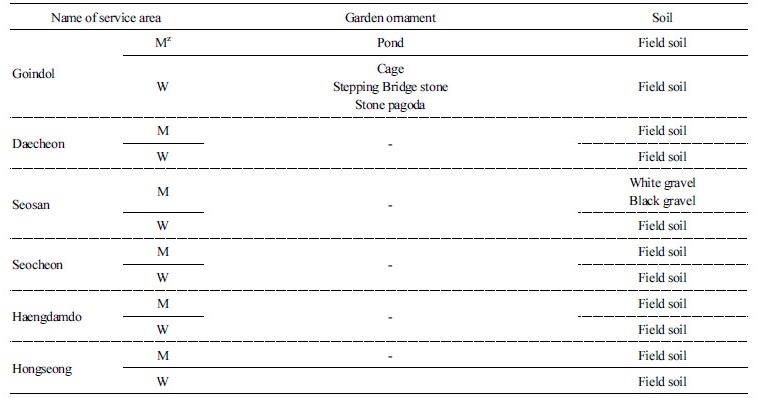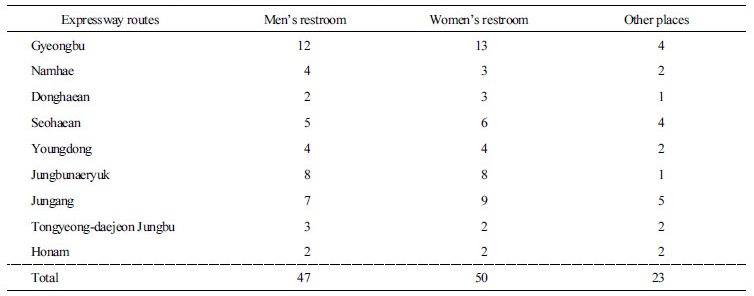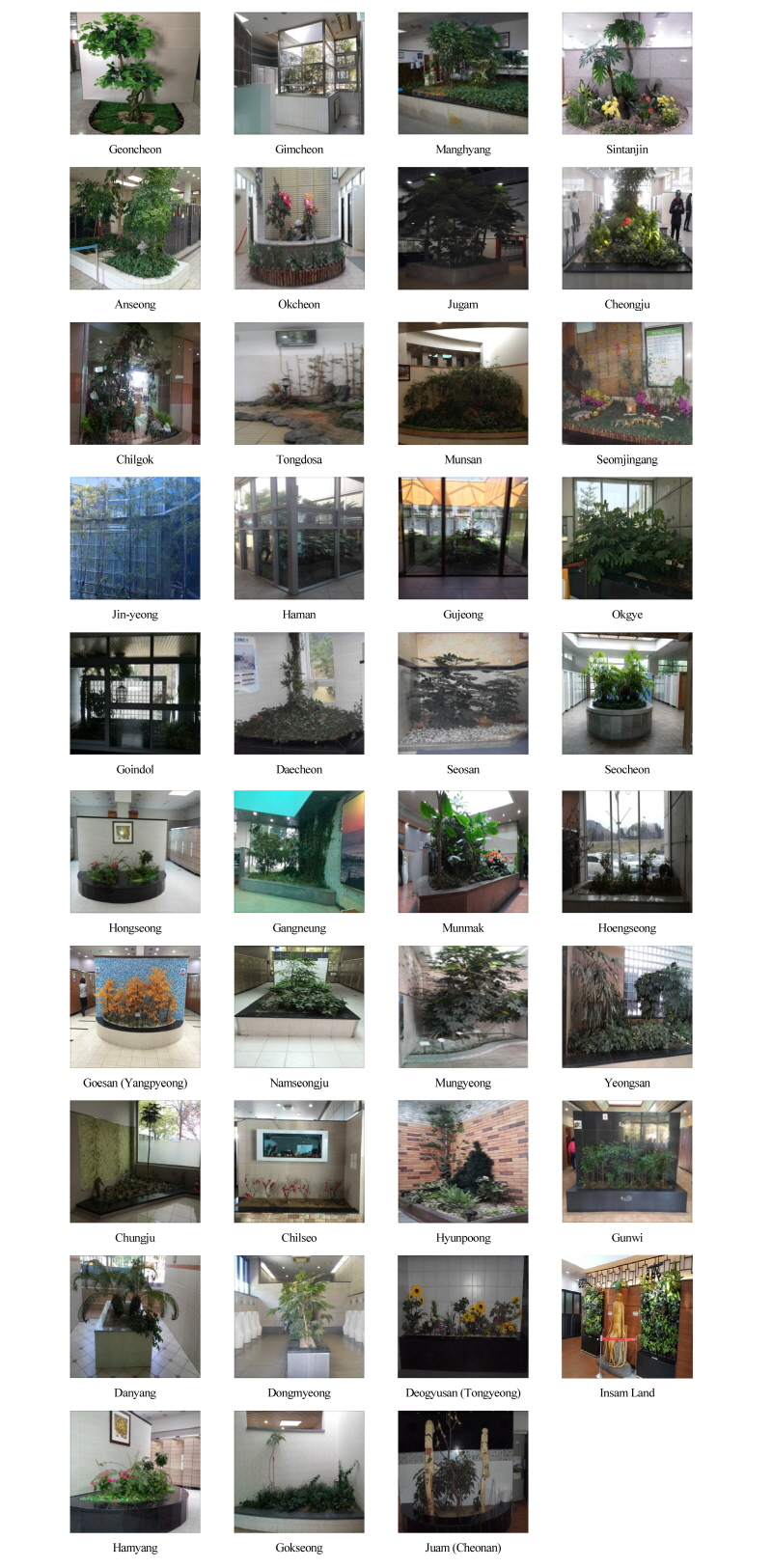Introduction
Gyeongbu Expressway, which has the Route┬Ā number 1 in South Korea, was opened on December 23, 1968 from Seoul to Suwon (23.6 km) and completed in July 1970 connecting to Busan, and was officially opened in August 1971. KoreaŌĆÖs first expressway service area is Chupungryeong Service Area (Lee et al., 2015), and as Naerincheon and Hongcheon Service Area also opened along with Seoul-Yangyang Expressway in June 2017, there are currently 189 expressway service areas in Korea (Korea Expressway Corporation, 2017).
An expressway service area is the hub of traffic and transportation that reflects the regionŌĆÖs image, and is the central space where many people come and go. However, while approximately 3.2 million vehicles a day are stopping by expressway service areas, they are merely serving as amenities or facilities for convenience such as to take a break, use the restrooms, refuel the car, or grab a bite (Choi and Lee, 2014). Most expressway service areas lack the ability to provide a pleasant resting place or efficient eco-friendly space for users.
According to studies on green space at expressway service areas in Korea, landscape space in service areas does not show differentiated features among service areas due to standardized establishment and implementation of plans according to the expressway landscaping standard drawing (Lee and Kim, 2011). In addition, landscape spaces and green areas have been eaten up rapidly due to the expansion of utilities and excessive implementation of commercial facilities led by increased users of expressway service areas (Lee et al., 2015). Moreover, Lee and Kim (2011) stated that it is necessary to create diverse and stereoscopic landscapes, increase the revegetation ratio, and expand resting places with nature in terms of improving design components of green spaces at the Youngdong Expressway service area. However, there has been almost no research on the indoor garden design in expressway service areas in Korea thus far.
Recently, garden-type interior landscapes have been widely constructed in expressway service areas as part of the policy to improve the environment and create a pleasant and beautiful expressway service area. Therefore, this study is conducted to examine the current state of indoor garden design in expressway service areas and determine the components of plants, garden ornaments and landscaping, thereby seeking effective ways to implement interior landscape.
Research Method
This study was conducted from September 2, 2016 to October 11, 2017. The current state of interior landscaping was determined by visiting 147 expressway service areas of 9 routes, such as Gyeongbu, Namhae, Donghaean, Seohaean, Youngdong, Jungbunaeryuk, Jungang, Tongyeong-Daejeon Jungbu and Honam Expressway, out of 189 expressway service areas nationwide operated by Korea Expressway Corporation.
The location of interior landscape in service areas was first examined, followed by cultivated plants, decorations of artificial flowers, and decorations of both plans and artificial flowers. The installation type, usage type mobility, and planter material were surveyed in both menŌĆÖs and womenŌĆÖs restrooms where interior landscape is installed. For the installation type, we distinguished the special combination type from general landscape type, such as garden type, planter-box type, artificial flower type, fountain type, and aquarium (Yun at al., 2016), We categorized usage type into appreciation, experience, and rest according to how users use interior landscape (Shin et al., 2013), and for mobility we determined whether the landscape is fixed type or portable type. We classified planter material into marble, glass and preservative wood.
Items such as garden ornaments or soil of interior landscape were also surveyed. The planting type of plants in the interior landscape is classified into upper, middle and lower plants. This study is limited in that it examined the current state of interior landscape in expressways nationwide, thereby not conducting statistical analyses aside from frequency analysis.
Results and Discussions
Current state of interior landscaping in expressway service areas
There were total 147 service areas in 9 major expressway routes in Korea, and 56 of them had interior landscaping, showing the ratio of 38.0% overall (Table 1). As for the number and ratio of service areas with interior landscaping per expressway route, there were 16 on Gyeongbu Expressway (47%), 4 on Namhae Expressway (30.7%), 3 on Donghaean Expressway (50%), 3 on Seohaean Expressway (33.3%), 4 on Youngdong Expressway (30.7%), 8 on Jungbunaeryuk Expressway (50%), 10 on Jungang Expressway (71.4%), 3 on Tongyeong-Daejeon┬ĘJungbu Expressway (16.6%), and 2 on Honam Expressway (13.3%). Compared to Gyeongbu Expressway, only 2 service areas on Honam Expressway had interior landscape installed, showing a remarkable difference. This low installation ratio of interior landscape is due to the fact that expressway service areas in Korea are still mostly for satisfying the physiological needs for long-distance travel, refueling, or selling commercial goods such as foods and beverages (Kwon et al., 2010), while lacking perception about improving resting places or serving as an interior landscape (Lee et al., 2015). Accordingly, it seems necessary to implement efficient interior landscaping for visitors at expressway service areas to feel refreshed, relieve fatigue, and enjoy a pleasant and beautiful atmosphere.
Location of indoor garden in service areas and current state of decoration type
The expressway interior landscapes were mostly in the restrooms (Table 2), with 47 gardens in menŌĆÖs restrooms and 50 in womenŌĆÖs restrooms, indicating that there were slightly more interior landscapes in womenŌĆÖs restrooms.
There were 35 expressway service areas decorated with natural flowers, 7 decorated with artificial flowers, and 14 decorated with a combination of both natural and artificial flowers (Table 3).
Indoor garden installation type, usage type and planter material in expressway service areas
This study analyzed the installation type, usage type, mobility and planter material of interior landscape installed in menŌĆÖs and womenŌĆÖs service areas for each expressway route of Gyeongbu, Namhae, Donghaean, Seohaean, Youngdong, Jungbunaeryuk, Jungang, Tongyeong-Daejeon Jungbu, and Honam Expressway (Table 4-10). As a result of examining the installation type of interior landscapes, 81 of them were general garden type with mixed plantations of multiple plants, taking up most of the landscapes, 4 were artificial flower type with a combination of special forms aside from plants, 4 were planter-box type, 1 was fountain type, and 3 were aquarium type (Yun at al., 2016). For usage type, all landscapes were to appreciate the indoor gardens without installing facilities for experience or rest (Shin et al., 2013). The mobility survey showed that all gardens were fixed type except for 3 places (Table 4-10).
For the types of interior landscapes installed in menŌĆÖs and womenŌĆÖs restrooms at Gyeongbu Expressway service areas, 18 were garden type, followed by 3 planter-box type and 1 fountain type. They were all for appreciation and installed as fixed type except for 1 portable type. Marble was most commonly used planter material, followed by installation of both marble and preservative wood, and then glass. Some service areas had interior landscape only on either menŌĆÖs or womenŌĆÖs restrooms (Table 4). Namhae Expressway and Donghae Expressway service areas also had the landscapes installed in garden type for appreciation in fixed form, with marble and glass used as most common planter materials (Table 5, 6). Haengdamdo Service Area on Seohaean Expressway had a single-file parallel type interior landscape, most for appreciation and in fixed type (Table 7).
The interior landscape installed in Chilseo Service Area on Jungbunaeryuk Expressway was aquarium type, while others were garden type installed for appreciation in fixed form, using marble and glass (Table 9). At Andong Service Area on Jungang Expressway, womenŌĆÖs restroom had the interior landscape installed in planter-box type, while other service areas were garden type installed for appreciation in fixed form, using marble (Table 10). In Deogyusan Service Area (Tongyeong direction) on Tongyeong-Daejeon Jungbu Expressway, menŌĆÖs restroom had the interior landscape formed with artificial flowers for appreciation in fixed form, using preservative wood. The others such as Insam Land and Hamyang Service Area were garden type installed for appreciation in fixed form, using marble (Table 11). The interior landscapes installed in menŌĆÖs and womenŌĆÖs restrooms on Honam Expressway service areas were also garden type for appreciation in fixed form, mostly using glass and marble for planter materials (Table 12).
The results of this study showed that most interior landscapes installed in service areas are mostly garden type for simple appreciation, thereby not displaying their functions properly (Yun et al., 2016). Therefore, it is necessary to improve practicality in the resting places of service areas and implement various designs that are refreshing and sophisticated (Bang et al., 2013), and to develop types of interior landscapes in expressway service areas considering irrigation control where it is easy to maintain and replace indoor plants.
Table 4. Installation and usage type of indoor garden in Gyeongbu expressway service areas.

|
|
| zM=MenŌĆÖs restroom; W=WomenŌĆÖs restsroom. | |
Table 5. Installation and usage type of indoor garden in Namhae expressway service areas.

|
|
| zM=MenŌĆÖs restroom; W=WomenŌĆÖs restsroom. | |
Table 6. Installation and usage type of indoor garden in Donghean expressway service areas.

|
|
| zM=MenŌĆÖs restroom; W=WomenŌĆÖs restsroom. | |
Table 7. Installation and usage type of indoor garden in Seohaean expressway serviece areas.

|
|
| zM=MenŌĆÖs restroom; W=WomenŌĆÖs restsroom. | |
Table 8. Installation and usage type of indoor garden in Youngdong expressway service areas.

|
|
| zM=MenŌĆÖs restroom; W=WomenŌĆÖs restsroom. | |
Table 9. Installation and usage type of indoor garden in Jungbunaeryuk expressway service areas.

|
|
| zM=MenŌĆÖs restroom; W=WomenŌĆÖs restsroom. | |
Table 10. Installation and usage type of indoor garden in Jungang expressway service areas.

|
|
| zM=MenŌĆÖs restroom; W=WomenŌĆÖs restsroom. | |
Table 11. Installation and usage type of indoor garden in Tongyeong-daejeon Jungbu expressway service areas.

|
|
| zM=MenŌĆÖs restroom; W=WomenŌĆÖs restsroom. | |
Table 12. Installation and usage type of indoor garden in Honam expressway service areas.

|
|
| zM=MenŌĆÖs restroom; W=WomenŌĆÖs restsroom. | |
Interior landscape garden ornaments and soil in expressway service areas
Types of garden ornaments for some interior landscapes installed in expressway service areas of each route include wooden fences, stones, pond, Korean traditional totem pole symbolizing love and hope, and ginseng model, and also other materials such as light, bird cage, stone pagoda, male and female figures, duck model, and water mill. Most common soil type was field soil, decorated with white or black gravel on top (Table 13-20). Recently, service areas in some regions succeeded in increasing the rate of use and customer satisfaction by repairing the facilities, creating a space with a distinctive theme of regional characteristics and using regional tourism resources by making good use of the eco-friendly architecture and surrounding natural environment, thereby improving their competitive edge compared to other service areas (Lee and Kim, 2011). The results of the study also showed that Deokpyeong, Insam Land, Goindol and Seomjingang Service Areas had interior landscapes well installed in restrooms using various items that represent the regional attributes (Fig. 1).
Table 13. Soil conditions and introduced material for indoor garden in Namhae expressway service areas.

|
|
| zM=MenŌĆÖs restroom; W=WomenŌĆÖs restsroom. | |
Table 14. Soil conditions and introduced material for indoor garden in Donghaean expressway service areas.

|
|
| zM=MenŌĆÖs restroom; W=WomenŌĆÖs restsroom. | |
Table 15. Soil conditions and introduced material for indoor garden in Seohaean expressway service areas.

|
|
| zM=MenŌĆÖs restroom; W=WomenŌĆÖs restsroom. | |
Table 16. Soil conditions and introduced material for indoor garden in Youngdong expressway service areas.

|
|
| zM=MenŌĆÖs restroom; W=WomenŌĆÖs restsroom. | |
Table 17. Soil conditions and introduced material for indoor garden in Jungbunaeryuk expressway service areas.

|
|
| zM=MenŌĆÖs restroom; W=WomenŌĆÖs restsroom. | |
Table 18. Soil conditions and introduced material for indoor garden in Jungang expressway service areas.

|
|
| zM=MenŌĆÖs restroom; W=WomenŌĆÖs restsroom. | |
Table 19. Soil conditions and introduced material for indoor garden in Tongyeong-daejeon Jungbu expressway service areas.

|
|
| zM=MenŌĆÖs restroom; W=WomenŌĆÖs restsroom. | |
Table 20. Soil conditions and introduced material for indoor garden in Honam expressway service areas.

|
|
| zM=MenŌĆÖs restroom; W=WomenŌĆÖs restsroom. | |
As for the soil, there are studies on light artificial soil combinations with excellent ability to remove contaminants from the air that are also good for plant growth (Jang et al., 2013). Accordingly, it seems necessary to replace interior landscape soil in service areas that is mostly field soil with the kind that has functionality to improve the environment and is also economically feasible.
Cultivated plants in expressway service areas and photographs of interior landscape
There were total 30 species, 27 genus and 19 families planted in interior landscapes of expressway service areas (Table 21). They were classified into upper, middle, lower and flowering plants according to tree height and planting type (Yoon, 1989; Lee, 1996).
There were 10 species, 9 genus and 6 families of upper plants, such as Chamaedorea elegans, Cycas revoluta, Fatsia japonica, Phyllostachys bambusoides, Phyllostachys nigra, Pseudosasa japonica, Rhapis excelsa, Rhapis humilis, Ternstroemia gymnanthera (Wight et Arn.) Sprague, and Washingtonia filifera (L. Linden) H. Wendl. For middle plants, there were 9 species, 8 genus and 8 families such as Araucaria heterophylla, Ardisia crenata Sims, Ardisia japonica (Thunb.) Blume., Aucuba japonica, Forsythia koreana, Nandina domestica Thunb., Ophiopogon japonicus, Rhododendron schlippenbachii, and Schefflera arboricola. There were 8 species, 7 genus and 6 families for lower plants such as Euphorbia pulcherrima, Farfugium japonicum, Hedera helix, Hedera rhombea, Hosta plantaginea (Lam.) Asche, Liriope platyphylla, Pachysandra terminalis, and Pteridium aquilinum var. latiusculum. As for flowering plants, there were 3 species, 3 genus and 3 families such as Aquilegia buergeriana var. oxysepala, Kerria japonica for. plena, and Viola tricolor var. hortensis.
A study by Jung et al. (2006) on the current state of interior landscape plants in 28 expressway service areas in Korea showed that there were 44 species and 26 families, but this study presented that there were 10 species and 7 families fewer. This may be because some plants withered away due to the poor environmental conditions at the entrance or lack of light in the restrooms, or also because they were replaced with plants that are more convenient to maintain.
Conclusion
This study determined the current state of interior landscaping by visiting expressway service areas of 147 service areas on 189 expressways in Korea. There were 56 service areas with interior landscapes, showing a ratio of 38%. On Gyeongbu Expressway with the biggest number of service areas, 16 (47%) out of 34 service areas had interior landscapes installed. Other routes had 10 or fewer. Moreover, 35 expressway service areas were decorated with natural flowers, 7 with artificial flowers, and 14 with a combination of both natural and artificial flowers. Expressway interior landscapes were mostly installed in the restrooms: 47 in menŌĆÖs restrooms and 50 in womenŌĆÖs restrooms. The most common type of interior landscape was fixed garden type, and 3 of them had portable planters installed. Most interior landscapes did not have resting facilities installed around them, with focus mostly on interior landscape itself to simply watch and appreciate it.
There were total 30 species, 27 genus and 19 families planted in interior landscapes of expressway service areas. It turned out that there were 10 species and 7 families fewer than previous research. This indicates that it is necessary to implement various plants that present seasonality and beauty of plant colors while also well enduring the indoor environment.
Recently, there is more and more resting space as expressway service areas seek various changes in terms of function. However, there are very few interior landscapes in service areas compared to exterior landscapes. It is necessary to install the interior landscapes, which are limited only to menŌĆÖs and womenŌĆÖs restrooms, to other spaces such as souvenir shop, cafeteria and information center. Furthermore, there is a need for various interior landscape designs that display the beauty of plants as well as artistic functions and environmental control beyond just garden type. It is also desirable to come up with a distinctive interior landscape to lead to specialized regional service areas. Visitors can enjoy both a spectacle as well as natural landscape if resting places are installed around the interior landscape, thereby improving the image of service areas, helping visitors relieve fatigue of both body and soul, and providing a pleasant environment.













